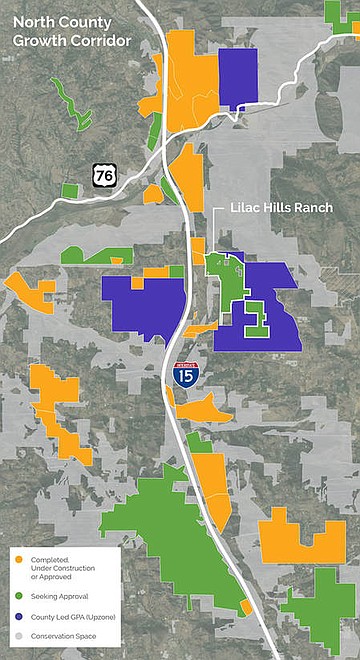 Facebook
Facebook
 X
X
 Instagram
Instagram
 TikTok
TikTok
 Youtube
Youtube

On a scrubby sweep of land in Otay Ranch, home to the tiny Quino checkerspot butterfly, developers want to build a village. The small colony of endangered butterflies is among the last in the county – unlike the development that threatens to oust them.
Forty-five miles north, on remote fire-prone slopes, other developers want to build thousands of homes. A swarm of such proposals in recent years brought Measure A to voters last week.
At the core of the Initiative, also known as Safeguard Our San Diego Countryside, is the county's general plan, often praised for corralling sprawl and focusing growth near existing villages and amenities, though some disagree.

"The general plan doesn’t prevent sprawl; it promotes unmitigable, long term, invincible sprawl," says Duncan McFetridge, with Cleveland National Forest Foundation.
In recent years, developers have tried to stretch the plan's boundaries into the boondocks where land is cheaper. It's easy for them to propose, McFetridge says, "because there is a lot of 2-4 acre "sprawl zoning in rural areas just outside of the village boundary."
And supervisors, mired in a housing crisis, kept making exceptions to the general plan.
Measure A, fought by the building industry, would have ended all that. Any housing project seeking to amend the general plan to build more than five homes in rural and semi-rural parts of the unincorporated county would be put to a countywide vote.
Also on the March 3 ballot was Measure B, aimed at a single project near Escondido, and whether the county's approval should be affirmed. Newland Sierra would build 2,100 units on land zoned to allow 99. Supervisors had made an amendment to allow 2,135.
In an odd twist, voters have rejected both measures. So, no voter-checks on backcountry sprawl...and no Newland Sierra. Not now, anyway. Other big projects have been voted down only to return, like Lilac Hills Ranch.
Measure A would only have applied to new general plan amendments. Many of the proposals that inspired it are inching ahead. While supporters think the county will be slower to approve such plans, losing Measure A means a fight over every single project – even though the issues are the same.
Environmental groups like the Sierra Club have filed lawsuits challenging the county's climate action plan, which they say ignores the emissions that will arise from the far-flung housing.
An upcoming appellate court decision on the climate action plan "could throw a wrench in the county’s environmental impact report approvals," McFetridge says. "Without a legal CAP, the general plan is invalid."
After supervisors approve a general plan amendment, the Local Agency Formation Commission must approve or deny changes such as annexation of rural land into a city's sphere of influence.
According to the commission's website, six "substantive" proposals are expected to be submitted in the next few months. Three involve city annexations in North County to accommodate large housing projects that include Harvest Hills and Sager Ranch in Escondido, and Rancho Lomas Verdes in Vista.
Valiano and Harmony Grove Village South had their county approvals overturned in January by the San Diego Superior Court.
Approval of Adara, the subdivison in Otay Ranch with the endangered butterfly, was challenged by conservation groups; the complaint described an area “at serious risk for fast-moving, wind-driven fires.”
It's not that there's nowhere left to put homes within the county's development blueprint. Since the general plan was adopted, 5,802 homes have been built in the unincorporated communities, leaving room for another 60,748 homes.


On a scrubby sweep of land in Otay Ranch, home to the tiny Quino checkerspot butterfly, developers want to build a village. The small colony of endangered butterflies is among the last in the county – unlike the development that threatens to oust them.
Forty-five miles north, on remote fire-prone slopes, other developers want to build thousands of homes. A swarm of such proposals in recent years brought Measure A to voters last week.
At the core of the Initiative, also known as Safeguard Our San Diego Countryside, is the county's general plan, often praised for corralling sprawl and focusing growth near existing villages and amenities, though some disagree.

"The general plan doesn’t prevent sprawl; it promotes unmitigable, long term, invincible sprawl," says Duncan McFetridge, with Cleveland National Forest Foundation.
In recent years, developers have tried to stretch the plan's boundaries into the boondocks where land is cheaper. It's easy for them to propose, McFetridge says, "because there is a lot of 2-4 acre "sprawl zoning in rural areas just outside of the village boundary."
And supervisors, mired in a housing crisis, kept making exceptions to the general plan.
Measure A, fought by the building industry, would have ended all that. Any housing project seeking to amend the general plan to build more than five homes in rural and semi-rural parts of the unincorporated county would be put to a countywide vote.
Also on the March 3 ballot was Measure B, aimed at a single project near Escondido, and whether the county's approval should be affirmed. Newland Sierra would build 2,100 units on land zoned to allow 99. Supervisors had made an amendment to allow 2,135.
In an odd twist, voters have rejected both measures. So, no voter-checks on backcountry sprawl...and no Newland Sierra. Not now, anyway. Other big projects have been voted down only to return, like Lilac Hills Ranch.
Measure A would only have applied to new general plan amendments. Many of the proposals that inspired it are inching ahead. While supporters think the county will be slower to approve such plans, losing Measure A means a fight over every single project – even though the issues are the same.
Environmental groups like the Sierra Club have filed lawsuits challenging the county's climate action plan, which they say ignores the emissions that will arise from the far-flung housing.
An upcoming appellate court decision on the climate action plan "could throw a wrench in the county’s environmental impact report approvals," McFetridge says. "Without a legal CAP, the general plan is invalid."
After supervisors approve a general plan amendment, the Local Agency Formation Commission must approve or deny changes such as annexation of rural land into a city's sphere of influence.
According to the commission's website, six "substantive" proposals are expected to be submitted in the next few months. Three involve city annexations in North County to accommodate large housing projects that include Harvest Hills and Sager Ranch in Escondido, and Rancho Lomas Verdes in Vista.
Valiano and Harmony Grove Village South had their county approvals overturned in January by the San Diego Superior Court.
Approval of Adara, the subdivison in Otay Ranch with the endangered butterfly, was challenged by conservation groups; the complaint described an area “at serious risk for fast-moving, wind-driven fires.”
It's not that there's nowhere left to put homes within the county's development blueprint. Since the general plan was adopted, 5,802 homes have been built in the unincorporated communities, leaving room for another 60,748 homes.
Comments